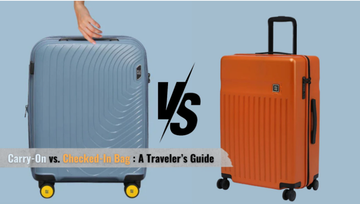The eternal debate between carry-on and checked baggage continues to challenge travelers worldwide. This comprehensive guide breaks down the key differences, helping you make the right choice for your next journey while ensuring a smooth travel experience.
Understanding the Basics
The fundamental distinction between carry-on and checked baggage lies in their handling during your flight journey. While a carry-on accompanies you in the aircraft cabin, stored either in the overhead compartment or under the seat in front, checked baggage travels separately in the cargo hold. This basic difference shapes everything from your packing strategy to your overall airport experience.
Size and Weight Restrictions
Airlines maintain strict regulations regarding baggage dimensions and weight limits to ensure safe and efficient travel. A standard carry-on typically measures 22 x 14 x 9 inches (56 x 36 x 23 cm), with weight restrictions generally falling between 7-10 kg (15-22 lbs). Many travelers appreciate that these dimensions allow for sufficient packing while ensuring the bag fits comfortably in overhead bins or under the seat in front.
Checked baggage offers more generous allowances, with maximum dimensions typically reaching 62 linear inches and weight limits around 23 kg (50 lbs). These expanded limits prove particularly valuable for international flights or extended trips requiring additional clothing and supplies.
The Personal Item Advantage
Beyond your primary carry-on, most airlines permit a personal item - a significant benefit often overlooked by travelers. This additional bag, whether a laptop case, small backpack, or purse, must fit under the seat in front of you. The personal item proves invaluable for keeping essential items within easy reach during your flight, from travel documents to entertainment devices.
Navigating the Check-In Counter Experience
Your choice between carry-on and checked baggage significantly impacts your airport experience. Travelers with only carry-on luggage often enjoy a streamlined process, bypassing the check-in counter entirely if they've completed online check-in. This time-saving advantage proves particularly valuable during tight connections or early morning flights.
Those choosing checked baggage should factor in additional time for the check-in counter process. While this might mean earlier arrival at the airport, many travelers find the trade-off worthwhile for the extra packing capacity. The check-in process typically involves:
-
Baggage weight verification
-
Security screening
-
Luggage tag assignment
-
Destination confirmation
International Flight Considerations
International travel introduces additional complexity to the baggage decision. Weight allowances and size restrictions often vary by region and carrier. Some international routes offer more generous checked baggage allowances, while others maintain stricter limitations. Security protocols also tend to be more rigorous for international flights, affecting both carry-on and checked baggage.
Smart Packing Solutions from EUME World
Modern travelers seeking premium luggage solutions will find innovative options in EUME World's collection. Their Cabin Pro Series features TSA-approved locks, built-in USB charging, and durable polycarbonate construction - perfect for carry-on needs. For those requiring more space, the Trunk Check-In Plus offers expandable capacity and silent-run wheels, ideal for longer journeys.
Making the Right Choice
The decision between carry-on and checked baggage should reflect your specific travel needs. Short trips of 1-5 days typically work well with carry-on luggage, offering convenience and cost savings. Longer journeys or trips requiring special equipment might necessitate checked baggage despite additional fees and handling time.
Consider these key factors when deciding:
-
Trip duration and destination
-
Airline baggage policies and fees
-
Need for special items or liquids
-
Time constraints at departure and arrival
Travel Tips for Both Options
Regardless of your choice, certain packing principles enhance any journey. Keep valuable items and essential documents in your carry-on or personal item. Use compression techniques to maximize space, and always verify your airline's specific requirements before packing.
Ready to elevate your travel experience? Visit EUME World (www.eumeworld.com) to discover their premium collection of travel bags. Whether you prefer carry-on convenience or checked baggage capacity, EUME offers innovative solutions combining style, durability, and smart features for every type of traveler.
FAQs
Is it better to have a carry-on or checked bag?
Your trip's length and nature should guide this choice. Carry-ons excel for short trips and quick exits, while checked bags better serve longer journeys.
Is a suitcase a carry-on?
Any suitcase meeting airline size restrictions (typically 22 x 14 x 9 inches) qualifies as carry-on luggage.
Why is checked bag more expensive?
Additional handling, storage requirements, and labor costs contribute to checked baggage fees.
How do I know if my bag is a carry-on?
Measure your bag against airline specifications, typically 22 x 14 x 9 inches for standard carry-on size.
What's the maximum weight for international checked bags?
Most international flights permit up to 23 kg (50 lbs) per checked bag, though limits vary by carrier and route.























